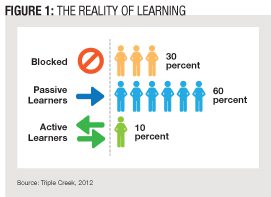Passive learners quietly take in new information and knowledge, but they typically don’t engage with the information they get. They may not interact with people, share their insights or contribute to the conversation. These behaviors can negatively impact the learning experience for even the most enthusiastic participants, and an estimated 60 percent of people are passive learners, according to a 2009 presentation from leadership development firm Lominger.
The prevalence of passive behavior has made increasing and facilitating active learning one of the learning leader’s biggest challenges. Only about 10 percent of people are active learners, according to the same Lominger presentation. The remaining 30 percent are blocked, closed off from even hearing about or trying to learn something new (Figure 1).

The rationale behind active learning is simple: Active learning focuses on changing behaviors. People who actively engage in learning do so intending to change their behavior, unlike passive learners, who may learn the right words to say but do nothing to actually alter how they work.
For learning leaders, having engaged employees who actively seek to learn how to change their behavior is an enticing proposition. Yet Debra Clawar, global head of talent management, leadership development and staffing for Novartis Pharmaceuticals AG, issues this caveat. “The more global experience I’ve gained, the more I’ve realized that expecting everyone to be an active learner is simply not realistic. We need to understand the cultural imperatives in a particular place that play into learning styles, and then meet those employees on their terms.” Clawar suggested learning leaders use different approaches and methods for different audiences.
To accomplish this, learning professionals need to construct learning environments, events and processes that encourage active participation and speak to employees in ways that trigger an innate need and desire to learn. People must be engaged in the learning, not just signing up and showing up. Participation is not engagement.
Technology has made it easier for employees to connect and join in learning activities, but passive learners tend to lurk in the background, soaking up information from people who are engaged in conversations but contributing little to nothing themselves.
To help employees engage as active learners, learning leaders must tie motivation to learning. This motivation needs to be personal and deep for people to want to take action. Demonstrating how individual learning needs can be met through modern collaboration and mentoring is key.
Motivation for Collaboration
Clawar said that passivity itself is a learned behavior. “Watch any toddler explore the world around them and you see the epitome of active learning. Intervening factors like cultural and behavioral norms at the societal level or within the family environment play a strong role in teaching children to convert from active to passive styles.”
Toddlers actively engage with their environment because they’re motivated. They want that toy or snack or the TV remote, so they figure out how to get to it, reach for it and start exploring it. Personal motivation also can be used in the workplace by tapping into employees’ innate desires.
Universally, people are driven by imagination, passion and experience. Tapping these can motivate people to collaborate. For instance, when colleagues seek out a co-worker because of his or her expertise, that employee’s motivation to share and collaborate goes up. When people make connections between what they are learning and their own interests or experiences, their motivation also goes up.
Health care company Humana put a method in place to leverage this principle in conjunction with its individual development planning process. “One issue that sometimes occurs is that associates look to the leader to determine the learning opportunities and provide them a plan or map of how to reach their goals,” said Pam Cradic, learning analyst for talent management and development at Humana. During the last few years, the company has been working to shift this by developing and promoting a shared responsibility philosophy.
Using both formal and informal learning and development opportunities, Humana tries to match areas of employee motivation with individual career goals so leaders can work with employees to align learning opportunities with professional goals.
“Depending on the associate and the goal, the development activity might include a formal class, a stretch assignment, participation in a mentoring exchange, hands-on learning or job shadowing, or a self-study course,” said Kelly Young, who works in Humana’s integrated learning area.
The company offers a suite of resources including an internal social networking platform called Buzz, a social learning and mentoring platform called The Knowledge Exchange, manager-level training on developing talent, and human capital processes such as the talent review. This multi-pronged approach creates a sophisticated mechanism for people to engage in learning at the time and in the manner that makes the most sense for each individual.
“Associates are now taking an active role in seeking out learning and development opportunities and leveraging our social platforms (Buzz and The Knowledge Exchange) to connect with the right people and knowledge when they need it,” Cradic said. “By adding in the social networking platform, associates have found an environment that supports their ownership and subsequently has helped in the adoption of active two-way learning.”
Differences in technologies can lead to variances in active learning levels, however. For example, technology that supports simple Q&As or comment posting will often result in lower levels of active learning engagement than technology that requires deeper knowledge exchanges and collaboration, such as with learning groups. This is because lurking behaviors are the norm on social networking sites. Have a question? Go see what other people have to say about it on the message boards.
But when a group anticipates and requires deeper informational exchanges with members, such as in a modern mentoring and collaboration network, lurking behaviors go down and active participation goes up. These groups have clear goals and direction and a clear sense of purpose for why the individuals are coming together. With this clearer purpose comes a higher sense of accountability. People participate in these knowledge-sharing networks to meet a personal or career goal or to address an issue that is vitally relevant to them.
For Humana, The Knowledge Exchange has formalized social connections by providing a framework to define goals and timelines. Young said it also offers a way to connect directly into an individual’s development plan.
Novartis is also seeing impressive results due to mentoring and knowledge sharing. Clawar said results from its global employee engagement survey indicate that associates who self-identify as being in mentoring relationships have higher levels of engagement, are less likely to leave the company and expend greater discretionary effort. “If we can expand the reach of mentoring and deeper knowledge sharing in the organization and convert some of those passive learners to active, we can enhance our overall engagement and organizational performance,” Clawar said.
Build an Active Learning Culture
Learning leaders can foster active learning by incorporating the following ideas into strategies and programs.
Set up learning environments and systems that are personally motivating. Give employees the ability to choose what learning topics they pursue, and give them a central place to go online where they can engage in knowledge sharing that is meaningful to each person involved. Novartis implemented an online approach to mentoring two years ago called My Learning Network @Open Mentoring.
“We specifically wanted to help connect employees in intentional learning relationships. We learned from our global employee survey and subsequent focus groups that employees wanted more opportunities to learn from others in the organization and weren’t sure how to break geographical, functional and hierarchical lines,” Clawar said. “Today we continue to build our participation base thanks to the success we’ve experienced. Now the tool has gone viral and been embraced in multiple divisions with a huge global reach.”
Look for systems that have push and pull. These systems don’t encourage passivity, as some social networking options might. Instead, they create a sense of personal obligation to contribute to the learning conversation going on, and do not allow people to just be takers of information.
Humana uses its Buzz social networking site to announce new learning topics and engagements occurring in The Knowledge Exchange social learning and mentoring system. This helps spread information via the technologies employees use daily to communicate with one another, and connects casual conversations in Buzz with learning opportunities that exist in The Knowledge Exchange (Figure 2).

Reward and recognize people for building the organization’s learning culture. Employees who participate in and contribute to learning conversations and collaborations are a critical talent asset. These are the people who help build the learning culture and provide a positive example of how to engage in learning. Publicly acknowledging their efforts and activities can showcase what good learning behavior looks like and encourage others to emulate it.
Randy Emelo is president and CEO of Triple Creek, an enterprise mentoring and knowledge sharing systems company. He can be reached at editor@talentmgt.com.















